

2021-10-241620
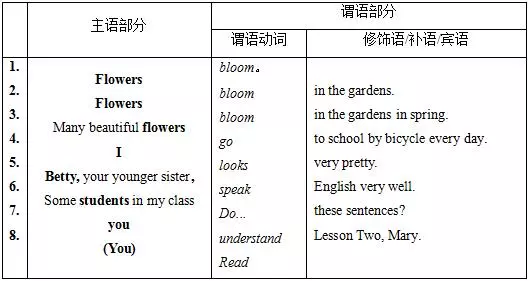
句子的成分
1. 主语—主语是谓语讲述的对象,表示所说的“是什么”或“是谁”。一般由名词、代词、不定式或相当于名词的词或短语来充当。它在句首。
注意:不定式作主语时,常用形式主语it句型。
2. 谓语—说明主语“做什么”,“是什么”或“怎么样”。
谓语(谓语部分里主要的词)必须用动词。谓语和主语在人称和数两方面必须一致。它在主语后面。
3. 表语—表语说明主语“是什么”或者“怎么样”,由名词、形容词、副词、介词、不定式及相当于名词或形容词的词或短语来担任。它的位置在系动词后面。
_注意区别:My job is teaching.(teaching 为表语) 与 I am teaching now.(am teaching 为谓语)
4. 宾语—宾语是动作、行为的对象,由名词、代词、不定式或相当于名词的词、短语来担任,它和及物动词一起说明主语做什么,在谓语之后。
5. 状语—状语用来修饰动词、形容词或副词。一般表示行为发生的时间、地点、目的、方式、程度等意义,一般由副词、介词短语、不定式或相当于副词的词或短语来表示。状语一般放在句末,但有的可以放在句首、句中。
6. 定语—定语是用来修饰名词或代词的。形容词、代词、数词、名词、介词短语、不定式或相当于形容词的词或短语等都可以担任定语。因为它是修饰名词或代词的,而名词和代词又可以作主语,还可以作表语和宾语,所以定语的位置很灵活,凡是有名词、代词的地方都可以有定语。
简单句、并列句、复合句
1. 简单句
句型:主语+谓语
只包含一个主谓结构,而句子的各个结构都只由单词或短语表示。
2. 并列句
句型:简单句+并列连词(或连接副词)+简单句
_由两个或两个以上的简单句并列连接起来的句子叫并列句。并列句中的各简单句意义同等重要,相互之间没有从属关系,是平行并列的关系。它们之间用连词连结。
1、联合关系:
常用的连词有and, not only…but(also), neither…nor等。
Eg. Tom doesn’t smoke, nor does his brother.
2、转折关系
常用的连词有but, yet, still, however, while(而,然而),when(那时,然后)等。
Eg. He got up very early, (and) yet he failed to catch the morning train.
We played outside till sunset, when it began to rain.
She is tired, (but) still she will make another test.
_yet 和still是连接副词,又叫半连接句。
_however(然而,不过,但是)意义接近yet,可放在句首、句末或插入句子中间。
3、选择关系:
常用的连词有or(或者,还是,否则),otherwise, or else, either…or等。
Eg. Hurry up, or we’ll be late for school.
4、因果关系
连词有:for, so, thus, therefore, and so 等。
Eg. He studied hard, thus he succeeded in passing the exam.
The Frenchman coughed loudly, so he decided to go and get some medicine for it.
_for 表示附加或推断的理由、原因。 Therefore较so更正式,and so 较口语化。
3. 复合句
句型:主句+连词+从句;或连词+从句+主句(包含一个主句、一个或一个以上的从句,或只包含一个从句,但有两个或两个以上的主句的句子叫复合句。)
动词时态,被动语态
一、一般现在时
1.一般现在时表示经常发生、习惯性动作、客观真理、科学事实、格言,目前的特征、状态、能力等。
2.主句是一般将来时,时间、条件状语从句中用一般现在时表示将来。如:
I’ll go there after I finish my work./ If it rains tomorrow, I won’t go there.
3.在以here, there开头的句子里,go, come等少数动词的一般在时表示正在发生的动作。
例如:There goes the bell.铃响了。There comes the bus.汽车来了。Here she comes.她来了。
二、现在进行时
1.表示正在进行的动作。
2.表示按计划安排即将发生的动作。
例如:She is leaving for Beijing.她要去北京。
He is working as a teacher tomorrow.从明天起他要做老师。
My father is coming to see me this Saturday.这个星期六我爸爸要来看我。
3.代替一般现在时,描绘更加生动。
例如:The Changjiang River is flowing into the east.江水滚滚向东流。The sun is rising in the east.太阳从东方冉冉升起。
4.大多数动词可用于进行时,但也有些动词不用于进行时。常见的有:exist, live, understand, mean, owe, belong to, know, doubt, suppose, remember, forget,
believe,trust,want,wish,refuse,like,hate,dislike,prefer,mind,hope等。
三、现在完成时
1.表示过去发生的动作对现在产生的影响或结果,或说话时已完成的动作。
例如:I have finished the report./ She has cleaned the room.
2.表示从过去开始,待续到现在的动作或状态,往往和“for…”, “since…”表述的一段时间状语连用。例如:He has learned English for six years./ They have worked here since they left college.
3.现在完成时与一般过去时的区别:
1)用两种时态来表述发生在过去的某一动作,现在完成时强调这一过去动作对现在产生的影响或结果,而一般过去时只表达过去的动作或状态,和现在关系不大。例如:She has cleaned the room. It’s very clean now.(此句has cleaned就不能改为cleaned.一是因为cleaned与现状无关,二是因为一般过去时不可突然跳到It’s…这样的一般现在时。)
2)汉语中的“了”、“过”、“曾”等词常用完成表达,如:I have seen that film.(我看过那部电影了。)但是如果是在特定的过去时间“看了”、“做过”,就不可用完成时而必须用一般过去进来表达。例如:When did you see that film? I saw it yesterday.(你什么时候看了那部电影?我昨天看的。)不能说:When have you seen that film? I have seen it yesterday.
4.表示“曾经到过某地(人已回来)”用“have/has been to”,表示“到某地去了(还未回来)”用“have/has gone to”.例如:
——Where is Li Hua? -He has gone to the reading-room.
——She knows a lot about Shanghai.-She has been there.
5.短暂动词(即瞬间动词),join, lose, buy, borrow, leave, go, come, arrive, die, marry, finish, complete, begin, start, break out等,在完成时态中,其肯定式不能和表示一段时间的状语连用。例如不能说:He has finished the work for three hours.要翻译“他已完成工作三小时了。”可采用1)“ago法”:He finished the work three hours ago.2)“延续法”:He has been through(with)the work for three hours.3)“since法”:It is/has been three hours since he finished the work.
四、现在完成进行时
1.用来表示从过去某一时刻开始一直持续到现在(或今后还要继续一去)的动作。例如:He has been doing the maths problems since 8:00./ It has been raining for two days.
2.凡是不能用于现在进行时的动词均不能用于现成完成进行时。
五、一般过去时
表达特定的过去时间内发生的动作或存在的状况,或过去某一时间内经常发生或反复发生的动作或行为。
六、过去进行时
1.表示过去某一时刻或某一段时间内正在进行的动作(这一过去时间须用时间状语表示)。例如:He was preparing his lecture all day yesterday.
2.表示动作在另一过去动作发生时进行。例如:They were still working when I left.
3.用在两个过去进行时动作同时发生。例如:I was writing while he was watching TV.
4.表示过去将来动作。例如:He said she was arriving the next day.
七、过去完成时
1.表示在过去某一时间以前已经完成的动作。例如:He had shut the door before the dog came up./ Everything had been all right up till this morning.
2.表示动作或状态从过去某个时刻开始一直延续到另一个过去时刻才完成,甚至还要继续下去。例如:At the age of ten, he had learned 500 English words. He had been ill for a week when we learned about it.
3.常用hope, expect, think, intend, want, suppose等动词的过去完成时来表示未实现的希望、打算或意图。例如:We had expected that you would be able to win the match.
八、一般将来时
一般将来时表示将来要发生的动作和存在的状况。有下列一些形式:
1.will/shall do (侧重将来行为,不突出计划安排去做某事)
2.be going to do (主观上打算或客观上可能发生)
3.be doing (按计划将要发生,常和表示最近的将来时间连用)
4.be about to do (按计划即将发生)
九、将来完成时
用来表示在将来某个时刻(前)将完成的动作。常和by短语,when, before引起的时间状语连用。例如:We will have finished senior Book 2 by the end of this term.
被动语态
一、被动语态的句型
1.常见句式是:主语(受动者)+be+过去分词+(by+施动者)
例如:He was scolded by the English teacher.
2.主语+get+过去分词+其它成分
例如:The boy got drowned last summer./ She got fired because of her faults.
注意:使用这种结构不能带有“by+施动者”
3.带有双宾语(直接宾语和间接宾语)的主动句变为动句,其主语可以是直接宾语,也可以是间接宾语。
例如:?She lent me a bike.
被动:1)I was lent a bike(by her). 2)A bike was lent to me(by her).
4.情态动词+be+过去分词
例如:This problem must be worked out in half an hour.
5.双重被动式:主语+被动式谓语+不定式的被动式+其它成分
例如;These magazines are not allowed to be taken out of the reading-room./The murderer was ordered to be shot.
二、主动表示被动的几种情况
1.不及物动词与状语连用,用以表示主语的品质和状态。常见动词是:cut, sell, read, write, fill, cook, lock, wash, drive, keep等。例如:This knife cuts well.这把刀好切。These books sell well.这些书好卖。The pen writes smoothly.这支笔写起来流畅。Meat won’t keep long in such hot weather.肉在这样热的天气里放不长久。The cloth washes well.这种布好洗。
2.一些连系动词的主动式+形容词。常见动look, smell, taste, sound, feel, prove, turn out等。
例如:The apples taste good./The flower smells wonderful./The news proved/turned out true./Cotton feels soft.
注:prove也可用于被动式,如:His answer(was) proved right.
3.不定式在某些形容词之后,且与主语有动宾关系。常见形容词有:hard, difficult, easy, heavy, fit, good, comfortable, convenient, impossible等。例如:The problem is easy to do./The question is difficult to answer./The box is heavy to carry./The project is impossible to complete in a year.比较:The problem is to be done./The question is to be answered.没有形容词时,虽然不定式与主语是动宾关系,但必须用被动式。
三、容易误用被动语态的几种情况:
1.I teach myself French.不可变为Myself is taught French.因为反身代词不可作主语。
2.We help each other/one another.不可变为Each other/One another is helped by us.因为相互代词不可作主语。
3.He lost heart.不可变为Heart was lost by him.因为象lose heart, make a face, keep silence, lose in thought这类动宾结构的固定短语只能用于主动式,不能用被动式。
4.She took part in the sports meet.不能变为The sports meet was taken part in by her.因为象take part in, belong to ,own, have, hate, fail, contain等表状态动词没有被动语态。
主谓一致Agreement
在英语的句子中,谓语动词的形式应与主语的人称和数保持一致。如何判定,则要看句子的意思。多数情况下,根据句子的主语形式就能判定,但有的则要看整句的意思,及强调的内容。下面我们就常用的、易混的几种情况作一下解释。
1、以单数名词或代词、不定式、动名词短语或从句作主语时,谓语动词要用单数形式。如:
1)To work hard is necessary.(It is necessary to work hard.)
2)How you get there is a problem.
2、复数主语跟复数动词。
3、在倒装句中, 动词的数应和它后面的主语的数一致。如以here, there开头,be 动词与后面第一个名词一致。如:1)Here comes the bus.
2)On the wall were two famous paintings.
3)Here is Mr Brown and his children.
4、and连接两个或两个以上的并列主语时,谓语动词用复数。如果主语后跟有with, together with, except, but, perhaps , like, including, as well as, no less than, more than, rather than等引起的短语,谓语动词仍与短语前的主语的形式保持一致。如:
1)Jane, Mary and I are good friends.
2)He and my father work in the same factory.
3)His sister, no less than you, is wrong.
4)The father, rather than the brothers, is responsible for the accident.
5)He, like you and Xiao Liu is very diligent.
6)Every picture except these two has been sold.
7)Alice with her parents often goes to the park on Sundays.
8)Alice as well as her friends was invited to the concert.
9)Nobody but Mary and I was in the classroom at that time.
5、并列主语如果指的是同一个人、同一事物或同一概念时,谓语动词用单数,and后面的名词没有冠词。如:
1)The writer and worker is coming to our school tomorrow. 这位工人作家明天要来我们学校。
2)Bread and butter is their daily food. 面包和黄油是他们每日的食品。
3)The writer and the worker are coming to our school tomorrow.(两个人)
6、and连接的并列单数名词前如有each, every, no, many a修饰时,谓语动词要用单数形式。如:
1)Every boy and girl has been invited to the party. 所有的孩子都被邀请参加这次聚会。
2)No teacher and no student is absent today.
3)Many a student is busy with their lessons.
7、each, either, one, another, the other, neither作主语时,谓语动词用单数形式。如:
1)Each takes a cup of tea.
2)Either is correct.
3)Neither of them likes this picture.
8、由every, some, any, no构成的合成代词作主语时,谓语动词用单数形式。如:
1)Is everyone here?
2)Nothing is to be done. 没有什么要干的事儿了。
9、关系代词who, that, which等在定语从句中作主语时,其谓语动词的数应与句中先行词的数一致。如:
1)Those who want to go please sign their names here.
2)Anyone who is against this opinion may speak out.
3)He is one of the students who were praised at the meeting.
10、表示时间、距离、价格、度量衡等的复数名词或短语作为一个整体看待时,其谓语动词常用单数形式。
11、复数形式的专有名词作为整体看待(如人名、地点、国家、组织、书籍、报刊等),动词用单数形式。如:
1)The United States is in North America.
2)The United Nations has passed a resolution(决议)。
3)“The Arabian Nights”(《天方夜谭》)is an interesting book.
12、有些集体名词如family, team, group, class, audience(听众,观众),government等作主语时,如看作是一个整体,谓语动词则用单数形式;如强调各个成员时,谓语动词要用复数形式。如:
1)My family is going to have a long journey.
2)My family are fond of music.
3)The class has won the honour. 这班获得了荣誉。
4)The class were jumping for joy.
13、all, more, most, some, any, none, half, the rest等作主语时,既可表示复数意义,也可表示单数意义,谓语动词要根据实际情况而定。如:
1)All of the apple is rotten. 整个苹果都烂了。
2)All of the apples are rotten. 所有的苹果都烂了。
3)Most of the wood was used to make furniture (家具)。
14、the + 形容词(或分词)作主语时,常指一类人,谓语动词用复数形式。如指的是抽象概念,谓语动词则用单数形式。如:
1)The young are usually very active.
2)The wounded are being taken good care of here now.
15、or, either…or…, neither…nor…, whether…or, not only…but (also)连接的是主语,谓语动词与后一个主语一致。如:
1)Either you or I am going to the movies.
2)Not only you but also he is wrong.
16、不可数名词没有复数形式,作主语时,谓语动词用单数形式。如:
1)Water is a kind of matter.
2)The news at six o’clock is true.
17、集合名词如:people, police ,cattle等作主语,谓语动词用复数形式。如:
1)The police are searching for him.
2)The cattle are grassing (吃草)。
18、population当人口讲时,谓语动词用单数形式;当人们讲时,谓语动词用复数。如:
1)The population of China is larger than that of Japan.
2)One third of the population here are workers.
19、the number of + 名词复数,是表示“…的数字”,作主语时,谓语动词用单数形式;a (large / great) number of + 名词复数,表示许多,作主语时;谓语动词用复数形式。
1)The number of the students in our school is increasing year after year.
2)A number of students have gone for an outing.
20、means, politics, physics, plastics等作主语时,谓语动词用单数形式。
复合句
( 1 ) 定语从句
I. 定语从句起了形容词的作用,在句中修饰一个名词或代词。被修饰的词叫做先行词,引导定语从句的词叫关系词,他的作用一是放在先行词与定语从句中间起了连接作用,二是在从句中担当一个成分,并与先行词保持数的一致。
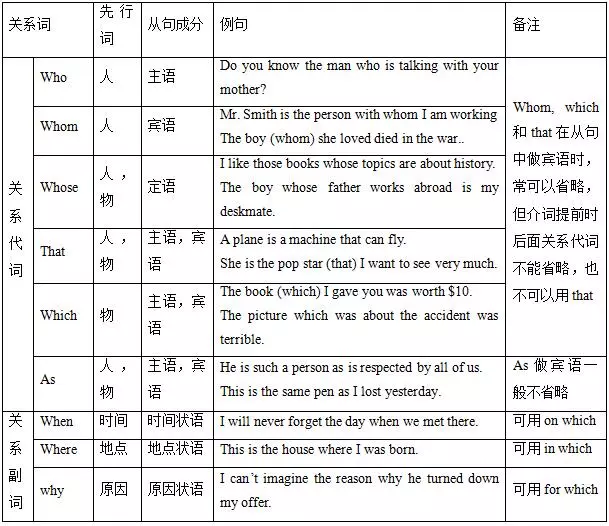
II. That与which, who, whom的用法区别:
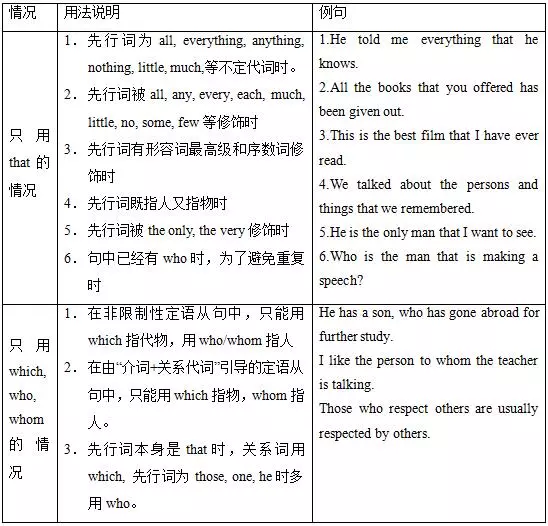
III. As与which的区别:
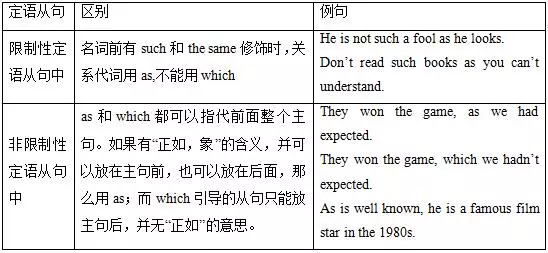
IV. 限制性定语从句与非限制性定语从句的区别:
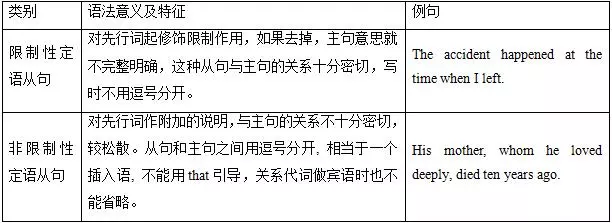
( 2 )状语从句
状语从句在主从复合句中修饰主句中的动词、形容词或副词等,按意义可分为地点、原因、目的、结果、条件、方式、比较等。
1、时间状语从句
由从属连词when, whenever, as, while, before, since, once, till. Eg. I waited till he had finished his work.
A. when, as, while 作时间从属连词的区别。
When可引导持续性动作,又可引导短暂性动作。它可表示主从句的动作同时发生,或从句的动作发生在主句动作之前。 Eg. When I was a boy, I used to go to the seashore on Sundays. (同时)
B. as 引导持续性动作,侧重表示主句和从句动作同时发生。 Eg. He hurried home, looking behind as he went.
C. while “在某一段时间里”、“在……期间”
While引导的动作必须是持续性的,它也强调主句和从句动作的同时发生,往往侧重主句和从句动作的对比。
Eg. Please don’t talk so loud while others are working.
_当when, as, while(正当……的时候)表示主句和从句的动作同时发生时,可以换用。
_当when引导的状语从句是系表结构(名词作表语),其主语又和主句主语一致时,往往可用as引导的省略从句代替,应注意as在这里是连词,不是介词,后边名词与年龄有关。
Eg. As a young man(=when he was a young man)he was a postmaster.
D. before 如果when和before引导的句子位于主句之后,有时要译为“才”、“这时”等。
Eg. He almost knocked me down before he saw me. I was having lunch when someone knocked at the door.
E. by the time, each time, every time, immediately, the moment, soon after, shortly after等也可以作为连词,引导时间状语从句。Eg. Each time he came to Beijing on business, he would call on me. I recognized you the moment I saw you.
F. 时间状语从句中的谓语动词一般不能用任何一种将来时,只能用现在时或过去时态表示将来时。
E. hardly…when; no sooner ...than=as soon as
这两个句组只能用于过去时,即从句谓语动词用一般过去时,主句谓语动词用过去完成时。Hardly、no nooner放在句首时,主句主谓倒装。
Eg. He had hardly fallen asleep when he felt a soft touch on his shoulder.
Hardly had he fallen asleep when he felt a soft touch on his shoulder.
Eg. I had no sooner come home than it began to rain. No sooner had I come home than it began to rain.
2、 地点状语从句:where, wherever引导
Eg. Go back where you came from. Where there is water, there is life.
3、原因状语从句
由连词because, as, since, now than (既然,由于)
because引导的从句是全句意思的重心所在。在有上下文的情况下,可以不要主句而单独成句。as与since则不能。
在回答why开始的问句时只能用because。
_在强调句式中强调原因状语从句,只能用because引导从句,不能用as或since.
Eg. It was because he was ill that he didn’t go with us.
_as (由于)所引导的从句一般放在主句之前,说明原因;后边的主句说明结果。主句和从句表达的内容同等重要。 Eg. As there was no answer, I wrote again.
以as引导的从句位于主句之后时,它的力量更弱一些,类似一种附带的说明。As在口语中使用较多。
_since(既然,因为):用以表示显然的或已知的理由、原因。从句的意思是次要的,主句是全句意思的重心所在。
Eg. Since he can not answer the question, you’d better ask someone else.
_now that与since, as 同义。其区别是now that用来说明一种新情况,然后再加以推论,从句与主句的因果关系很小,而since和as连接的句子因果关系比较明显。
Eg. Now that you have finished the work, you are free to do what you like.
注意:_用了以上表示原因的从属连词,主句不可再用并列连词so.
_并列连词for有时表示因果关系,有时是对前面分句的内容加以解释或推断。
当for表示因果关系时,可和从属连词because同样使用,但语气较弱。
Eg. He could not have seen me, for (or: because) I was not there.
4、目的状语从句
that, so that, in order that, for fear that(以免,唯恐),lest(唯恐,免得):lest从句中谓语(should)+v, in case (万一)等。
Eg. We remained at home lest(=for fear that) they should come in our absence.
目的状语从句的消语常含有may(might),can, could, should, will等情态动词。通常主句在前,从句在后,主句与从句之间没有逗号。
_lest 只用于正式文体,在现代英语中多以for fear that, so that…not等代替。
5、结果状语从句
由连词that, so that, so…that , such…that etc.
注意区别that, so that引导的目的状语从句和结果状语从句。根据上下文来判断,从句之前有逗号的常是结果状语从句;从句中有情态动词的多半是目的状语从句。
Eg. She hurried, so that she caught the bus. (结果) She hurried so that she might catch the bus.(目的)
6、条件状语从句
通常由if, unless(除非),as long as, so long as只要,in case (that)万一
_unless 从句的谓语只能用肯定式
_主将从现
7、方式状语从句
连词as, as if(as though)等引导从句多用虚拟语气。 Eg. He walked as if he were drunk.
8、比较状语从句
as…as, not so (as)…as, than等引导 eg. Peter swims as well as Tom does.
_the +比较级(从句),the+比较级(主句) eg. The harder we work, the happier we feel.
9、让步状语从句
though, although, as(虽然),even if, even though, whoever, whatever, whichever, whenever, however, no matter who (what, which, etc)
eg. Wherever you work, you can always find time to study.
Whether he comes or not, we’ll discuss the problem this afternoon.
_让步状语从句可放在句首、句中、句尾
though与although同义。Although 较为正式,多置于句首,as引导的让步状语从句多用于书面语。它比用though(although)引导的让步状语从句更有表现力,语气更强。As引导的让步状语从句要使语序部分倒装。
Eg. Child as he was, he had to help support the family.
_even if (though)从句所说的不一定是事实。 Though从句一般说的是事实。
_whether一般引导名词性从句。当引导让步状语从句时,必须有逗号和主句分开,而且其前边可加no matter.
Eg. You’ll have to do it, (no matter) whether you like it or not.
_让步状语从句和主句之间不可再用but等纯并列连词,但可用yet, still, nevertheless等副词来加强语气。
Eg. Though he was tired, yet (still, nevertheless) he went on working.
_不可将no matter与“疑问词+ever”连用。
Eg. Whatever (no matter what )you say, I won’t agree you .
No matter whatever you say, I won’t agree with you .(错)
倒装句
I. full inversion
1、there (here) + be + S
eg. Here is the milkman. There comes the bus.
_在there和here的后面还可跟一些不及物动词,如stand, lie, go, fall等。句子的谓语时态为一般过去时或一般现在时。如例2
2、单个副词位于句首的倒装句
单个副词位于句首,句子的主、谓需倒装,表示强调。这类副词有in, out, now, up, down etc.句子的谓语一般为be动词或不及物动词。
Eg. Down came the rain. Up went the flag. Away he ran.
如果这类句子中的谓语动词是短语动词则不能将短语动词中的副词移到句首。
Eg. Up it blew.(错)____blew up: exploded
_但有时也例外,当句子的主语在对比的情况下,作主语的人称代词也可与作谓语的be 动词形成倒装。
Eg. There were they, reading in the classroom, while we were cleaning outside.
3、介词短语作状语位于句首的倒装句。在这类句子中,谓语一般为be或不及物动词。
Eg. Near the forest is a small lake. In the doorway stood my brother.
在上述单个副词和介词短语位于句首的倒装句子中,谓语用一般现在时或一般过去时。
4、so, nor, neither, no more 引导的倒装句,句子全部倒装。
Eg. He finished his job, and so did I. Peter doesn’t like pop music. No more does his brother.
Peter 不喜欢流行音乐,他兄弟也是如此。
_在美式英语中,通常认为nor不能跟在but或and的后面。
Eg. John didn’t see the accident and nor did Mary.(错) John didn’t see the accident and neither did Mary.(对)
_当句子的主语与前句的主语为同一人或物,而so位于该句的句首时,后面so引导的句子不用倒装。
Eg. It’s raining . So it is.
5、as引导的倒装句
在正式书面文体中,as引导表示比较含义的从句,句子常用倒装句。
Eg. He likes sports, as do most of his friends. 他和他的大多数朋友一样,喜欢体育。
He is a college student, as are his sisters and brothers.
II. partial inversion
1、副词位于句首的部分倒装句
一些含有否定意义的副词位于句首时,句子倒装:seldom, rarely, scarcely, hardly, barely, little, never, few, not until, not only等。
Eg. Little did he know about mathematics. 他的数学知识极为贫乏。
Rarely did students attend his lectures. 学生很少去听他的讲座。
_如果scarcely, hardly, little和barely等副词位于句首,但它们在句中修饰主语,此时句子不倒装。
Eg. Little help can be expected from John. 不指望从约翰那里得到多少帮助。
Hardly twenty students are in that big room. 在那间大房子里还不足20名学生。
2、only引导的部分倒装句。
Only位于句首,后接状语,句子要倒装。
Eg. Only on Sunday does he go home. Only alone, does she feel sad.
_only修饰宾语,位于句首时,句子也可以倒装。Eg. Only their teacher will they obey.
_only修饰主语,位于句首,句子不用倒装。Eg. Only two of us got tickets.
3、not only …but also…引导的两个分句,前一个分句用倒装,后一个分句用倒装,后一个分句用陈述结构。
Eg. Not only does he speak English but also he speaks German.
_not only不位于句首,句子则不倒装 eg. He not only speaks English but also he speaks German.
4、hardly…when…; scarcely…when…; no nooner…than…
eg. Scarcely had he come in when the guests wanted to leave.
5、not+名词或副词组成的词组在句子中作状语或宾语,位于句首,句子需倒装。
Eg. Not a letter did he send home. Not once do I meet him. 我一次也没有见到他。
Not until the end of this week did she realize her mistakes.
_not在句首修饰主语,句子不必倒装。 Eg. Not many people came to the party.
6、当含有no的词组位于句首时,句子用倒装。
_Nowhere else in the world can you buy a better and cheaper camera than in our shop.
No longer are they cooperating with us.
By no means should you break the rules. 你决不能违反规章制度。
At no time should we give in to difficulties. 任何时候都不应在困难面前屈服。
_类似的短语:in no way决不,in no sense决不,in no case决不,under no excuse毫无理由,on no account决不
如果这类短语不在句首,句子不用倒装。
7、在if引导的虚拟条件句子中,如有had, were, should,可将if省去,而将had, were, should移到句首倒装。
Eg. Had I not seen it with my own eyes, I would not have believe it.
8、as, though引导的让步状语从句,形容词、名词作表语常位于句首,形成倒装。
Eg. Small though the room is, it can hold more than twenty people. Child as he is, he knows a lot.(省略冠词)
情态动词
I. 情态动词基本用法:
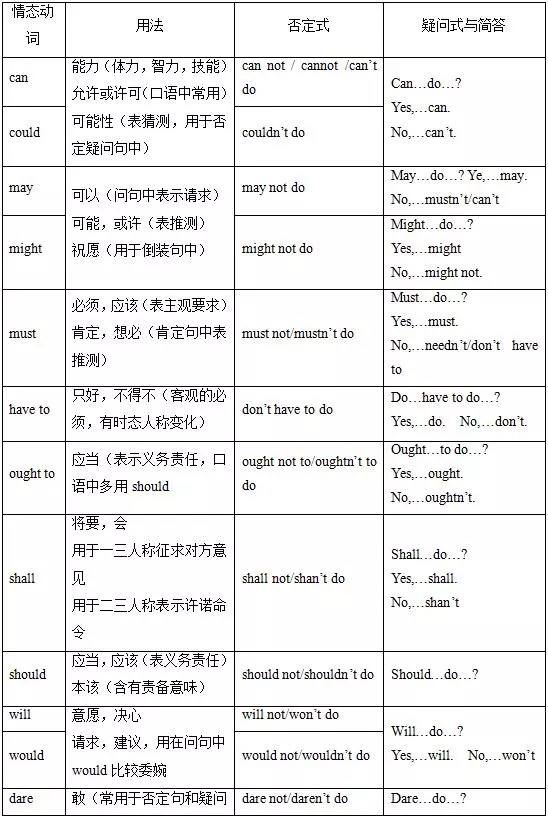
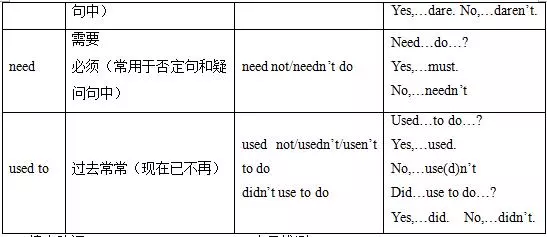
II. 情态动词must, may, might, could, can表示推测:
以must为例。Must + do(be)是推测现在存在的一般状态进行;Must + be doing 推测可能正在进行的事情;must +have done是推测可能已经发生过的事情。
He must be a man from America. / He must be talking with his friend. / He must have already arrived there.
1. must“肯定,一定”语气强,只用于肯定句中
2. may和might“也许”,后者语气弱,更没有把握。可用语肯定句和否定句。
He may not be at home. / They might have finished their task.
3. can和could“可能”,could表示可疑的可能性,不及can’t语气强,用于肯定否定疑问句中。
The weather in that city could be cold now.
We could have walked there; it was so near.(推测某事本来可能发生,但实际上没有发生)
Can he be in the office now? No, he can’t be there, for I saw him in the library just now.(语气很强,常用于疑问句否定句中)
III. 情态动词注意点:
1. can和be able to: 都可以表示能力。但be able to可以表达“某事终于成功”,而can无法表达此意。Be able to有更多的时态。另外,两者不能重叠使用。
2. used to和would: used to表示过去常常做现在已经不再有的习惯,而would只表示过去的习惯或喜好,不涉及现在。
3. need和dare作情态动词和实义动词的区别:
两者作情态动词时常用于否定句疑问句。其形式为:needn’t/daren’t do, Need/dare…do…?
做实义动词时可用于肯定句,否定句和疑问句。其形式为:need(needs/needed)/dare(dares/dared) to do, don’t(doesn’t/didn’t) need/dare to do
非谓语动词
I. 非谓语动词的分类,意义,构成:
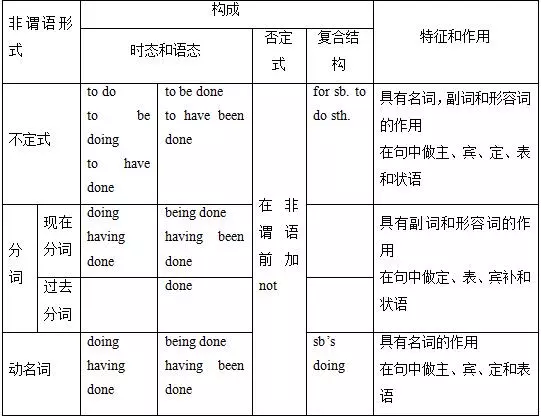
II. 做宾语的非谓语动词比较:
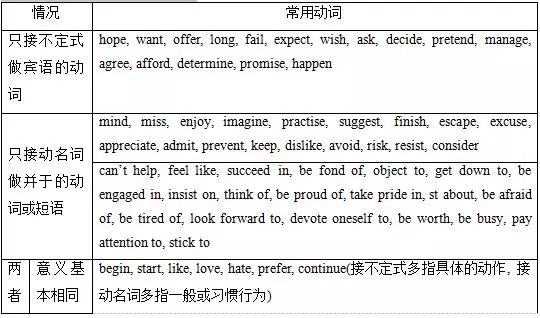
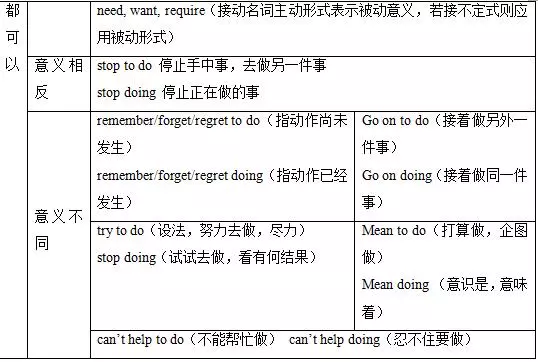
III.非谓语动词做宾语补足语的区别:
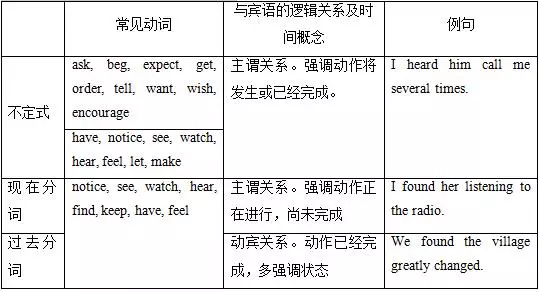
IV. 非谓语动词做定语的区别:
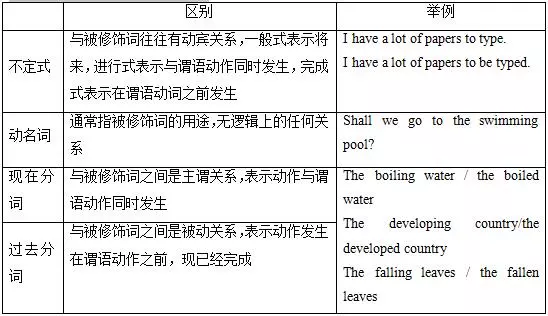
V. 非谓语动词做主语和表语的区别:
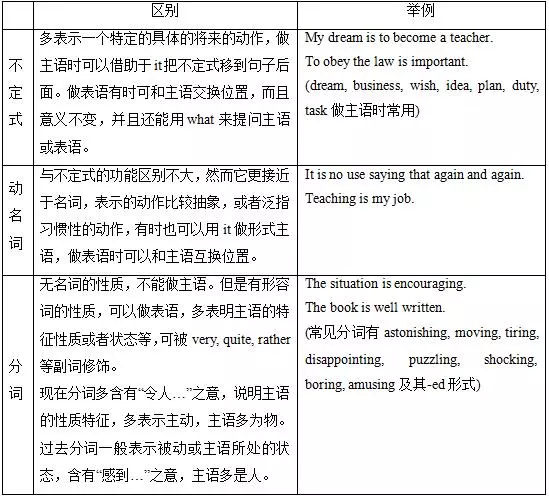
If和whether
I. if 和whether都能引导主语从句。只不过if 引导主语从句不放在句首,而放在句尾。句首用it 作先行词,而whether引导的主语从句可放在句首或句尾。
_有些语法书说if不能引导表语从句。而在实际阅读中if引导表语从句的句子也是有的。
Eg. The question is if we should go on with the work.
II. if 与whether不能互换的情况:
1、介词后用whether不用if eg. It depends on whether he’s ready.
2、不定式之前用whether, 不用if eg. He worried whether to come.
3、名词之后用whether不用if eg. The decision whether to see her was mine alone.
4、whether可和or not直接连用,if不能。 Eg. I don’t know whether or not he is ready.
5、引导让步状语从句用whether不用if: eg. Whether you like it or not, you will have to do it.
6、如果宾语从句放在句首,用whether不用if. Eg. Whether this is true or not, I can’t say.
7、如果宾语从句是个否定句,用if引导不用whether引导。 Eg. I don’t care if he can’t come.
ill和sick的区别和共同
ill和sick都有"生病的;有病的"之意,但用法并不完全相同。ill表示"生病的;有病的"这一意思时,一般用作表语,不能作定语;而sick?既可以作表语又可以作定语。同时sick?有"恶心的;厌倦的"之意。
ll和sick的具体区别是什么ill 表示"生病的;有病的"这一意思时,一般用作表语,不能作定语;而sick 既可以作表语又可以作定语,如"病人"可以说a sick man 或the sick, 但不能说an ill man 或the ill。又如:She is ill / sick in bed. 她卧病在床。She is looking after her sick father .她在照顾她生病的父亲。
sick 有"恶心的;厌倦的"之意。如:The smell makes me sick.这气味使我感到恶心。
ill 作定语修饰名词时是"坏的;邪恶的"之意。如:He is an ill man. 他是一个邪恶的人。
hear和listen to的区别
listen 是不及物动词,表示有意识或注意地“听”,必须加 to 才能接宾语。 hear是及物动词,表示“听见”,“听到”,可度能是有意识的听,也可能是无意识的听。
hear 和 listen to 的具体区分hear 和 listen to 有含义、侧重点和用法三个区别:
1、含义不同
hear意思是:听到、听见、得知。hear既是及物动词也是不及物动词,后面可以直接跟名词。
listen to意思是:听…(讲话)、听取、听从。listen to的listen是不及物动词,to为介词,listen to后面必须接有名词。
2、侧重点不同
hear 不是有意识的,强调听的结果。多表示无意识地听见,耳朵收到声音讯息就算。
listen to是有意识的,强调听的过程。用来表示注意正在持续发出的声音,强调集中注意力,想尽量听清楚。是有意识地听、仔细听,但不一定听到什么,强调的是听的动作。
3、在时态中的用法不同
当hear表示无意识的“听”时不能用于进行时态。举个简单的例子,就是不能说“I’m hearing you”,而要说“I can hear you”。
listen to主要是用来表示正在听。如果要表示从头到尾听完一次演出、演说、音乐节目、广播等,一般要用hear。Did you hear that play on the radio last night?(你昨晚收听了那出广播剧吗?)
网页1983年3月27日 — 《荆棘鸟》是高中读的一本家世小说,昨天动起念头看1983年8集连续剧版本的《荆棘鸟》纯粹是为了好奇和怀旧。 连续剧版剧本的安排让我注意到书里所不曾注意到的矛盾。
MIA 本来是军方用来指称在战斗或是任务中失踪的人员,. 但现在普遍在影集或是新闻中也会看到了~. 【例句】. After 10 years being declared MIA, the soldier is found alive in a small village. 在被认定为失踪十年后,这名军人在一个小村庄被发现。. 【补充】without a trace ...
1、专科女生-医学美容技术专业 该专业培养的是有较强的审美能力,掌握医学美容知识、美学知识,能够从事美容咨询或者顾问、美容培训、美容护理的专业人才。 2、 …
以上是新东方在线英语 六级 频道小编为大家带来的“2022下半年CET6考试时间确定啦! 12月10日举行”,希望考生们都能备考顺利,取得出色的成绩,顺利通过 四六级 考试。 想了 …
JooN SoON SEE YOU 下次见~ 关注再走哦 知心的高中老师 替弟弟还债的好姐姐 跟明里的一个作品同一个剧本 半年后 谁的演技最好?你们觉得呢?
国防生是指根据部队建设需要,由军队依托地方普通高校从参加全国高校统一招生考试的普通中学应届高中毕业生中(含符合保送条件的保送生)招收的,以国防生教育模式培养的新 …
985大学是我国为了培养世界一流大学所选拔出来的一批实力强劲的院校,从985工程开始到结束,985大学的实力变化大家也都有目共睹,小编就为大家带来全国985大学 …
网页行业词典. 爱词霸权威在线词典,为您提供反叛的中文意思,反叛的用法讲解,反叛的读音,反叛的同义词,反叛的反义词,反叛的例句等英语服务。.
一、报名要求. 1.我省全国大学英语四、六级考试口试、笔试考点均是由符合相关条件的高校提出申请并经山西省招生考试管理中心和教育部教育考试院审批通过后设立的。. 报名 …
我交到了许多好朋友用英语怎么说. 在大学里我学习了许多东西我也结交了许多好朋友翻译为英语是I learned a lot and made many good friends in college. 我们想结交相当多的朋友英语. we want to make so many friends. 他结交了好多朋友.英文翻译怎么写. He makes friends with many people. 结交新朋友的英文. make a new friend. 以上就是关于结 …
网页《勇士》 是由加文·欧康诺执导,加文·欧康诺和安东尼·唐巴基斯担任编剧,汤姆·哈迪,乔尔·埃哲顿和尼克·诺特联袂出演,影片于2011年9月9日在美国上映。影片讲述两位兄弟,一位是退伍军人,一位曾是高中老师。在搏击的赛场上,为朋友、为信仰、为家庭、为责任、以及为 …
,高中女生大胆出演性教育视频!6岁萌娃揭秘兴趣班套路!胖小子如何逆袭成”团宠“?,【纪录片】女性秘密 06,【纪录片】女性秘密 05,【纪录片】女性秘密 01,国产老 …
报名及缴费相关事项. 考生须在所在学校规定时间内通过全国大学英语四、 六级考试报名网站(cet-bm.neea.edu.cn)完成报考,其中包括信息核对、资格审核及网上缴费等操作。 报名网站支持支付宝、中银智慧付、招行一网通三种支付方式。 考生须对照片、学校及院系信息进行核对,如有错误须立即联系所在学校相关部门进行更 …
网页blossom [noun] flowers, especially of a fruit tree. apple blossom. flower [noun] the part of a plant or tree from which fruit or seed grows, often brightly coloured and sometimes including the stem on which it grows. a bunch of flowers.
吝啬 简体:吝啬 繁体:吝嗇 拼音:lin se 读音:lìn sè 英语: 近义词:悭吝、小气、小器、鄙吝、吝惜 反义词:大方、慷慨、豪奢 单字解释: 组词,组成语:吝 啬吝啬是什么意思词 吝啬怎么读 解答吝啬怎 …
岩下志麻Iwashita Shima(いわしたしま)日本女演员,1941年1月3日生于东京,父亲岩下清是一名演员和电影制作人,她的伯父是著名歌舞伎演员第四代河原崎长十郎。 岩下少年时就读于东京都立武藏高中并同时入选明星学院高中部。 高中毕业后,她考入成城大学文艺学院,后中途退学。 岩下先是在电视剧中出演配角,随后于1960年进入松竹 …
又名: Ping Pong The Animation. IMDb: tt3592032. 豆瓣评分. 9.5. 50468 人评价. 5星 79.3% 4星 17.0% 3星 3.1% 2星 0.4% 1星 0.2% 想看 在看 看过. 评价: 写短评. 写影评. 分享到. 推荐. 乒乓的分集短评 · · · · · ·. 1集 2集 3集 4集 5集 6集 7集 8集 9集 10集 11集. 乒乓的剧情简介 · · · · · ·. 片濑高中的新生“阿扁”星野裕(片山福十郎 配音)和“笑爷”月本 …
网页耦合 在电子学和电信领域, 耦合 (英语: coupling )是指能量从一个介质(例如一个金属线、光导纤维)传播到另一种介质的过程。 在电子学中,耦合指从一个电路部分到另一个电路部分的能量传递。
中国外贸坦克已经形成了一个高中低不同档次的系列,从VT1到VT4,可以满足不同外国客户的需求。在上个世纪,从仿制苏联坦克起家的中国,虽然也对外销售过坦 …
小强. 著. 【世界调制模式】(第一章 高中篇). 【世界调制模式】(第二章 周六篇). 【世界调制模式】(第三章 周日篇). 【世界调制模式】(番外之断裂的水管). 【世界调制模式】(第四章 初露锋芒篇)附番外篇 教师角色扮演. 【世界调制模式】(番外之 ...
网页爱词霸权威在线词典,为您提供屈辱的中文意思,屈辱的用法讲解,屈辱的读音,屈辱的同义词,屈辱的反义词,屈辱的例句等英语服务。 首页 翻译
理科女生适合做医生,教师等。医生待遇好是个热门的行业,教师工作稳定,也很热门。理科女生最热门专业1、师范类专业(化学、物理、数学)教师这个职业因为女生温柔细致 …
时间 考试种类 考试代码 考试时间 上午 英语四级考试(CET4) 1 9:00-11:20 下午 英语六级考试(CET6) 2 15:00-17:25
Web 结果2021年上半年全国大学英语四、六级考试将于6月12日举行,具体考试时间如下: 二、考前准备. 1.因本次考试须进行入场测温检查,为保证入场有序进行,英语四级考生需于8:00开始入场,9:00禁止入场;英语六级考生需于14:00开始入场, 15:00禁止入场。 南教考生排队等候地点:南教西门. 南堂考生排队等候地点:基础实验楼D区东侧(南 …
多年前父母去世后,榎本雄二被儿时好友尤娜、妮娜和母亲米拉 收养。现在在读高中,改名为椿原雄二,他和一对可爱的双胞胎和一个美丽的少妇住在同一个屋檐下。虽然害羞内向的尤娜和性格外向、才华横溢的妮娜是他的家人,但雄二在目睹 ...
母狗 Bitch (2017) 导演 : Marianna Palka 编剧 : Marianna Palka 主演 : 杰米·金 / 杰森·雷特 / 布莱特顿·沙比诺 / 埃里克·埃德尔斯坦 / 卡罗琳·阿隆 / 比尔·斯米托洛维奇 / 罗杰·格午埃文·史密斯 类型: 剧情 / 喜剧 / 动作 制片国家/地区: 美国 语言: 英语 上映日期: 2017-01-20(圣丹斯电影节) 片长: 93分钟 IMDb: tt6069264
网页提供新华字典汉字茜的基本解释含义和繁体字异体字怎么写、在线标准发音和拼音;茜计算机相关的Unicode编码,茜字的偏旁构造与笔画,与茜字相关的词语和成语,还有茜的英语、日本等国家语言读音和翻译以及中国各语系的其他方言读音。
展开全部 guess的英式读法是 [ɡes];美式读法是 [ɡes]。 作动词意思是推测;猜中;以为。 作名词意思是猜测;猜想。 相关例句: 1、I dont really know, Im just guessing. 我真的不知道, 我仅仅是猜想。 2、We could only guess at her motives. 我们只能猜测她的动机。 扩展资料: 单词解析: 1、变形: 名词: guesser 过去式: guessed 过去 …
2022年高考即将开考,考生们普遍在为考试调整状态,而家长则多是一边关注着学生的考前准备,一边给孩子们计划着大学、专业方向。那么,女生最吃香的十大专业有哪些呢?女 …
